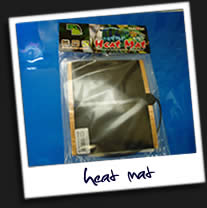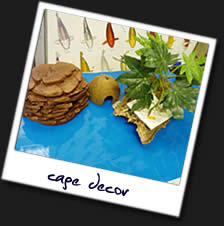www.reptiles-info.co.uk
Gecko Housing:
Here at reptiles-info we aim to guide you through housing your gecko by informing you of all the necessary equipment you will need in order to provide the perfect environment for your gecko.
Cage Setup:
When housing your gecko it is best to prepare your cage around a week before your gecko actually arrives in order to test that everything is working within your cage setup. There are several ways in which to house your gecko, including in a glass cage or a moulded plastic vivarium or a wooden vivarium. The later two being more suited, as they make it easier to maintain an even temperature. In order to make a successful environment for your gecko the factors that need to be covered are the cage size, heating, lighting, ventilation, decor and cleanliness and hygiene of your geckos cage all of which are covered in detail below.
Cage Size:
When selecting the appropriate housing for a reptile suLe as a Leopard gecko it is important to take into account the potential size to which the gecko can grow. Therefore I suggest when selecting a cage for your gecko, choose the largest one possible in order to accommodate the rapid rate of growth geckos have. However if you do not have the space for a large tank a minimum standard to go by when housing your gecko is 18 inches x 12 inches (45cm x 30cm) for a hatchling which would increase to 24inches x 12inches (60cm x 30cm) for an adult gecko. Also avoid having more than two males in a cage as this will cause fighting. Several females can be kept together if desired or a male with two or three females. It is best to avoid one male and one female as his persistent attention may be too much for the single female. The cage should ideally have plenty of room for an active gecko to maneuver with the ability for the gecko to climb, bask in a hotspot, move to a cooler spot, drink and hunt for food.

Heating:
The temperature of your geckos housing is crucial to your success in keeping a healthy animal. This is because geckos are cold blooded animals and rely on the environment around them in order to regulate their body heat. As you are trying to recreate a gecko’s natural habitat it is essential that there is a warm area and a cooler area within your reptiles housing. In order to provide the correct temperature a heat mat can be placed underneath your gecko housing (only with a glass tank. Heat mats need to be placed inside wooden or plastic vivs!). The mat should be half the size of the tank to ensure there is a cooler area. Important! Make sure there is only a very thin layer of substrate on top of the mat. Too thick a layer can lead to damage to the mat or vivarium. Heat mats will only raise the temperature around 10f above the back ground temperature. Therefore they are only suitable for use in warm rooms or as a background heat source when a heat bulb is also being used in the vivarium. A spot lamp or ceramic heater is the recommended method of heating for Leopard Geckos. The bulb should be installed at one end of the tank to create a temperature variation, the bulb should be controlled by an appropriate thermostat. Dimmer’stats are recommended for spot bulbs and puls proportional ‘stats for ceramic heaters. If you wi8sh to use a heat mat for background heat this should be installed at the same end of the vivarium as the heat bulb. The recommended temperature in a Leopard Gecko’s housing should be no cooler than 20°C with a warm area that does not exceed 38°C. For More Information On Reptile Heating Click Here
Lighting:
Unlike other reptiles Geckos do not need constant lighting or UV light to survive as they are nocturnal creatures, although it is best to provide a spot lamp to provide the gecko with a hot spot area within their housing as covered above in the 'Cage Heating' section. Lighting within a geckos housing is best kept on a timer switch that can be set to keep a constant cycle of light and dark as best as possible to mirror the day/night cycle. For the safety of your ges o it is best to keep the bulb out of reach in order to prevent the bulb burning your gecko. For More Information On Reptile Lighting Click Here
Ventilation:
As the geckos housing will be constantly heated the air inside of the vivarium or glass housing may become stagnant which will have an adverse effect on the geckos living inside. Therefore you will need to make sure that fresh air is ventilating the housing as regularly as possible. To help promote this try to use the draughts created by warm air rising to the top of the housing to extract the stagnant air and drag fresh air into the housing. Make sure there are vents low down at the front of the vivarium and towards the top the rear of the vivarium. You can also use a hand spray to spray the cage with a light misting of water in order to provide extra humidity for the gecko.

Cage Decor:
Selecting the correct substrate when housing your gecko is a very important factor that can have a severe effect on the livelihood of your gecko as some substrate can cause impaction when eaten. Therefore I suggest that any of the following would be suitable; newspaper, kitchen roll and reptile carpet, however if you want a more natural look I would suggest using fine sand. Many of the reptiles sands are such as Calci Sand are advertised as being digestible so are highly suitable. Other items that are useful in a gecko’s cage would be a hide box placed at both ends of the cage which helps to provide geckos with a secure area and another variation in temperature. In order to make the housing look more natural, repti-vines, logs, ledges and logs can all be added into the cage. You must also check that these items are secured otherwise they could move and hurt your pet gecko. I would also suggest including practical items into your geckos habitat such as a water dish and a calcium dish in order to keep your gecko healthy.
Cage Cleanliness:
The best way to keep your geckos housing clean is to remove any visible waste as soon as you see it, clean the water dish daily and disinfect it weekly. Schedule a routine clean complete clean of the housing once a month. This would involve removing all the substrate and wiping all surfaces and décor with a reptile disinfectant and adding fresh substrate. I advise that any item that can't be easily cleaned should be removed from the tank completely. Geckos will also leave their stools in the same area as they maintain their own habitat, this helps to ease cleaning as all waste can be removed easily and quickly.
Gecko Pages






